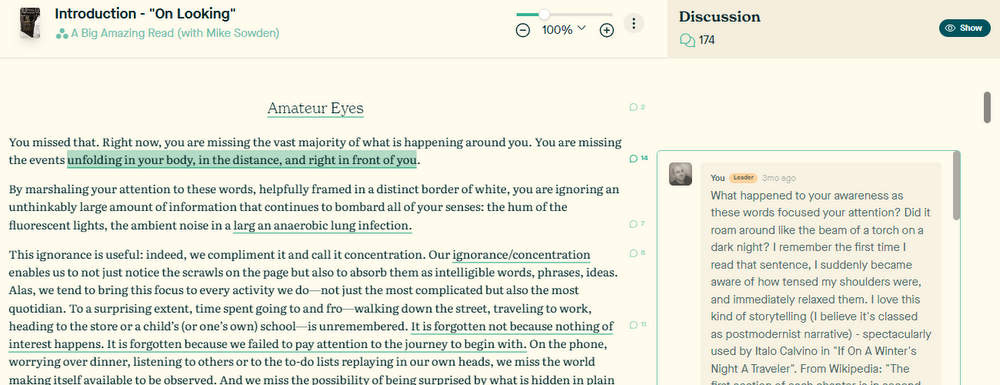Hello! This is Mike from Everything Is Amazing.
Two things in this one:
Firstly: as a break from talking about shipwrecked boys not murdering each other and how hopefulness isn’t a gift you have to surrender, we’re returning to this book:
In this first Big Amazing Read, we’re reading Alexandra Horowitz’s On Looking - one of the books that inspired me to start this newsletter.
This is mainly one of those “do it in your own time” things. Anyone can take part! All you need is to get hold of a copy of the book and read it - maybe in a street cafe, where you can put some of its ideas to immediate use.
Regarding where to get it:
New paper copies are a little hard to find (there’s only been one version, as far as I can tell). If you’re in the UK, the Simon & Schuster page for the book has a lot of great links; if in the US, try the Barnes & Noble page.
It’s on Amazon here (cheapest as a Kindle e-book) - and it’s also on Audible here, read by Horowitz herself.
Libraries! Marvellous things. Don’t get me started.
If you want a taster of the whole book, the introductory chapter - accompanied by my own commentary in the margins - is available to read on the social reading platform Threadable.
Click the image below to go there:
To take part in the rest of the Big Amazing Read, you can go through On Looking in your own time - but I’m also publishing my own discussion notes, chapter by chapter, in newsletters like this one, in case you want to read along. Chapters 1 and 2 were here.
(I frequently find my own voice very boring indeed, so, please, if you want to share your own perspective on this beautiful book with me and everyone else, please leap into the comments here. Thank you!)
Secondly: at the bottom of this newsletter, just for paid supporters, is a link to book an online chat with me sometime from the middle of October onwards - what I’ve been calling a “Curiosity Call” since I had chats with many of you at the end of last year.
The way it works is this:
We meet at the appointed time, on Zoom or using whatever platform or form you prefer (eg. a voice-only call).
We chat for about 30 minutes.
We end the call, and you think to yourself, “Well, I wonder what that was all about?!”
Maybe you have a newsletter idea you're wanting to bounce off someone else! You may have a nerdy hobby you want to lean into in a more curious and structured way, as I’ve done with EiA! You may have something entirely different going on that my brain is too small to currently imagine! (The third option is far more likely.)
Whatever it is: we meet, you can ask me questions or tell me interesting things, I try to fling a bunch of other questions or ideas at you, you take a note of any that might be worth chewing over - and off you go to discover how deep your personal rabbit-hole goes.
(Or: you turn up with an entirely different idea for how to use our time together, and I’ll do my best to accommodate.)
As I said, it’s just for paid subscribers, and places are limited. If you’re on the free list, here’s how to can upgrade to paid:
Okay! On with the discussion notes for On Looking.
“On Looking” - Chapter 3: Minding our Qs
A walk with Paul Shaw, professional typographer, ‘afflicted with the disorder of knowing too much...about the design of letters.’
(Header quote: “To see is to forget the name of the thing one sees.” - Paul Valéry)
We’re meeting a different flavour of guide here, that’s for sure.
As the chapter opens, Shaw is feeling actual pain at the sight of a bunch of mismatched typefaces. This isn’t the boundless and universally generous enthusiasm of Sidney Horenstein of the previous chapter, where everything is a joy waiting to be uncovered. Shaw has *opinions*.
As a professional letterhead, he knows the rules of good lettering taste, formal and unspoken, and when he sees them being broken, he cringes.
He’s also experiencing everyday things very differently to most people, because of his “curse of knowing”. Where we’d read lettering and our brains would instantly leap to their meaning, he is absorbed with the letters themselves.
There’s a fascinating parallel here with how Horowitz’s toddler in the first chapter sees shapes without yet having the skill of interpreting them into objects. Paul Shaw *can* interpret meaning from the letters he sees, but that’s not his primary skill when he reads.
“Every hour, children are losing more and more ability to think without language…”
Interesting aside here: do you have an inner monologue? (A primer.).
If you find you don’t, well, that’s two of us! As far as I can tell, my own thoughts aren’t “read out” by an inner-me voice inside my head as I think. I *can* make my own internal voice, but it’s an effort of imagination – and what normally happens, as far as I can tell, is that my thoughts take the form of...I don’t know, the meaning, landing in my brain in a swirl of impressions and sensations and imaginings? But it’s not a “voice.”
So – if children have the ability to think without language, and they lose it as they acquire words in their parents’ language, how is it that (I think!) some of us retain the ability to think without internally spoken language?
What Horowitz seems to be suggesting here is language as a strait-jacket, or a super-highway that excludes all other routes across our inner landscape. This is why learning a new language and becoming fluent enough to think in that language can literally become a new way of seeing the world.
But she’s also talking about “dull, tedious words” – the difference between fully playing with the possibilities of a language, and sticking to the vernacular, the roughly one thousand unique words we use every day on average, vs. the tens of thousands we know from the hundreds of thousands available if we made the effort. I’m not sure I’d judge everyday vocabulary as “tedious” by default, but it can be!
“Words are the ample cleavage of the urban environment: impossible to not look at.”
I laughed. But also, hey, did a man edit that line?
“Today we rarely encounter a public surface completely without words.”
Is this true? Or is it just a statement about New York? It feels like something to test. Wherever you are in the world, go for a walk and report back.
The anecdote about how badly designed taxi lettering can be was a really interesting illustration of how design can hijack meaning, an insider-baseball level of knowledge that Paul Shaw presumably has difficulty looking past.
(What’s your equivalent of this? What expertise do you find yourself unable to turn off so you’re having the same everyday experience of other people? For me, it’s story analysis – after working as a storytelling consultant, I find part of my brain always analysing a story even while I’m trying to enjoy it. If something seems technically clumsy to me about how the story unfolds – my equivalent of outraged good taste – I find it really hard to suspend my disbelief again.)
“ ‘I look at everything...when I do walking tours, I forget to look where I’m going.’ With all the signs, a person could get lost.”
Lovely irony there.
As he gets more and more obsessively interested in what he sees, Shaw is editing it in his head. This ‘A’ has to be lower. This ‘S’ is kerned in a weird way. It’s like he’s itching to intervene and correct what he sees. Something is WRONG and he wants to right it.
This can, of course, become obnoxious when someone does it to you in an unsolicited way. See how a slice of the population of Britain found themselves infuriated by Lynne Truss’s book Eats, Shoots And Leaves: The Zero Tolerance Approach To Punctuation, even while the rest propelled it to the top of the bestseller charts.
But also, the way that Horowitz describes him – despondent at an ugly sign for just 3 seconds before being distracted by something else – he has a kid’s diversive curiosity propelling him along. (How much of this was for Horowitz’s benefit and how much is what he does every day, I wonder?)
“Three hours of walking with Shaw later, I felt relieved...rather than words, I saw the components of words. Some small part of my brain (the linguistic part) rested: the shape-identifying part hummed with activity.”
I loved this observation – that it can be relaxing to be able to tune out meaning in favour of form, and all the rules attached to it.
And her final point about how people get the “Tetris Effect” from playing the game so long that their minds try to fit things together in the real world as they look at them – yep! As an archaeologist, I learned the equivalent: the “Trowel Effect”. As you’re walking along, part of you is assessing how to dig up whatever is in front of you. That big rock over there, where would I start, ah yes, scrape away *here* and then chase *that* edge down to see where it goes, and then you should have a good stab at levering it up….
We think as we do, not just the reverse. Teach the body, and the mind will follow – and that’s why physical movement (gesturing, pacing, using physical prompts) is such a huge benefit when you’re learning new things. Ask any actor!
“On Looking” - Chapter 4: Into The Fourth Dimension
Alexandra Horowitz goes walking with illustrator and ordinariness-curator Maira Kalman.
(Header quote: “The world is full of obvious things which nobody by any chance ever observes.” - Sherlock Holmes / Arthur Conan Doyle.)
I love how this chapter opens, with a request to stand on a street corner for half an hour without setting any expectations about what you’ll get out of it! On reflection, this may have inspired my ‘first law of curiosity’ (or I might just have stolen it). How often does the tyranny of usefulness in your planning get in the way of doing stuff just for the curious hell of it? I reckon we need more excuses to experiment with our free time without demanding results in advance, and this is certainly a good one.
Fascinating word, “ordinary”. In one sense it means “something that happens all the time” - but it’s also used as a synonym for “uninteresting”, as a judgement. Why would you live an ordinary live when it can be EXCEPTIONAL? Except - 95% of our lives are ordinary and when we forget it, we simultaneously get too big for our boots, and we start tuning out the everyday joys of life that are constantly around us. Thank heavens for all the artists reminding us to see what we’re looking at, and reminding us that the world we already have is where most of the things we’re looking for already reside…
“…we all create for ourselves: we summarize and generalize, stop looking at particulars and start taking in scenes at a glance - all in an effort to not be overwhelmed visually when we just need to make it through the day.”
Much truth here. Definitely applies to me, in my hastiest moments. We are pattern-scanners, more and more when we’re in a hurry, and “when we’re in a hurry” probably applies to most folk these days?
“Once you look at what seems ordinary enough, though, it often turns odd and unfamiliar, as any child repeatedly saying his own name aloud learns.”
The dream of any science writer (and journalist in general)! To slow people down enough to consider something properly that was sitting right under their noses all day long.
Kalman’s manifested talent in this chapter is to regard things as interesting without judging them on their ordinariness (in both senses) - like a child’s ability in the first chapter of On Looking, and presumably like a dog’s ability to regard all smells as fascinating information instead of labelling them good (and therefore worthy of attention) or bad (and therefore something to avoid).
“…it’s a sofa on the street, I cannot believe it!”
Case in point! 😂 The rest of us: oh dear, how messy and thoughtless mixed with euwww strangers were sitting on that for YEARS, I’m going nowhere near it. My reaction is often a bit more anthropomorphic: oh that’s sad, a sofa that served someone faithfully for years, maybe decades, just tossed out on the street like that. (As I wrote here, this happens to me a lot.)
“…we all have a sense of the “appropriate” personal space around us - a kind of zone of privacy that we wear, even on the social sidewalk.”
This is why we need cheeky, bold or just plain weird folk to nudge us out of those paths until we “breach” those rules, in the language of The City & The City. It’s the skill of good investigative reporters - and entertainingly intrepid writers like
(who you definitely should read, if you enjoy this book). Quite the skill, and I aspire to honing it in myself.“Kalman minded people’s spaces, but she seemed to see personal space as an indication that there was a person in that space to engage with.”
I love this so much. An awareness of other people not as a warning of obstacles to avoid but as an invitation to connect. Obviously this can go wrong if you mistake the signals of folk who just want to be left alone - but as a cautiously applied default response, it’s a good way to treat strangers, make new friends and learn a lot of things you never knew about other people (like, for example, that some people are absolutely lovely).
(That said: when they dive into the hallway of a building and get side-eyed by a security guard is a reminder of how dangerous things can get if your intentions are severely misconstrued - especially in a country with so much private gun ownership. Invading other people’s spaces is not something to take lightly.)
I previously referenced the section where Horowitz talks about the emotional intensity of a human gaze when I was writing about the science of extreme staring. But one thing I’d forgotten is this line: “researchers have found that in a controlled setting, we like unknown people who gaze at us more than those who do not.” As uncomfortably intimate as eye contact can be, it is generally better at conveying trustworthiness than eye-avoidance, although this is not always true at a specific level - for example with the overwhelm and anxiety that eye contact can bring to autistic people.
I found the discussion about sidewalk ownership and building accessibility really interesting and it’s got me curious about how it works here in Scotland. There’s always a tension between where you feel you shouldn’t go and where you probably could actually go, and I feel like there are lots of missed opportunities in that gap, that buffer zone of mutual avoidance and therefore social neglect. How often do we test these limits and feel comfortable when we do it or someone else does, because of how much it feels like an invasion or power-grab?
(One example of limits tested in a bad way: back in my home town in Yorkshire there’s a shop that keeps getting into trouble with the town council because its wares keep creeping out further and further into the street, to the point where they’ve been threatened with legal action.)
This is a walk that’s all about breaking unspoken rules, and about having the boldness and high-wattage curiosity to do it (and the affability to get away with it!). As an introverted British person who apologises for everything - including apologising - this is a chapter I’d want to ponder a lot more and turn into a few self-imposed challenges that hopefully won’t get me into trouble…
What about you? How does this chapter make you feel?
Give me your thoughts here! Thank you.
And now here are the details for those Curiosity Calls…







